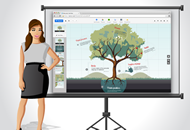Lesson Plan: A Primer on Student Presentations
by Sarah Sahr
 I’m sure all of you have been in this situation. You’ve given your students an assignment and they have to present something to a class as a whole. Now, for most people, this means create a PowerPoint, get some poster board, or just stand and deliver! This quick introduction lesson plan is very simple, nothing too arduous, just a class introduction. The fun part comes with the presentation. Students will be required to present themselves via an online platform. What’s great about presenting in this kind of format is that most of the software is free and it forces students to think through a presentation before standing in front of the class. They also have to speak each time a new slide appears. This is the key point!
I’m sure all of you have been in this situation. You’ve given your students an assignment and they have to present something to a class as a whole. Now, for most people, this means create a PowerPoint, get some poster board, or just stand and deliver! This quick introduction lesson plan is very simple, nothing too arduous, just a class introduction. The fun part comes with the presentation. Students will be required to present themselves via an online platform. What’s great about presenting in this kind of format is that most of the software is free and it forces students to think through a presentation before standing in front of the class. They also have to speak each time a new slide appears. This is the key point!
| Materials: Computers, the Internet, a mobile phone or camera (optional), stopwatches |
| Audience: All ages, all levels |
| Objective: Students will be able to introduce themselves to the class using an online presentation tool |
| Outcome: Students will create a digital introduction |
| Duration: 2-minute introduction per student, but it might take weeks to create |
Preclass Research
It is super important that you do your research on online presentation tools before you unleash your students, especially students who are not necessarily digital natives. These are my top three recommendations for presentation software (in alphabetical order):
Google Docs: You’ll need a Gmail account to use this application.
Prezi: Love it! It puts a whole new “spin” on presentations.
SlideShare: This was my first introduction to online presentations and will always have a place in my heart
Now, I’m sure many of you already know these sites. You can also look to SlideRocket, or Empressr… there are countless options out there. It’s important to remember that if you are asking your students to do something, you should be able to do it, too, so be sure to take the time to become comfortable with the software you choose if you’re not already familiar with it. (You may also have to set aside time to help your students create user log in information complete with passwords.)
This lesson should take place the first week of class; however, the presentation can take place at the end of the first month. To me, the proficiency level of the students determines the amount of time they need to present. If they are beginners, a 90-second presentation might be enough, but intermediates might need 3 minutes, and advance students could take 5–7 minutes. What’s most necessary is that they are incorporating the software into their introduction. Also, students should practice! Work time into your planning for practicing (more on that below).
Introduction
Let students know what they are responsible for completing. This chart might help decide what each proficiency level could accomplish:
| Beginning Level, 90 sec. |
Intermediate Level, 3 mins. |
Advanced Level, 5–7 mins. |
| Name |
Name |
Name |
| Age |
Age |
Age |
| Family |
Family |
Family |
| Heritage Language |
Heritage Language |
Heritage Language |
|
Occupation |
Occupation |
| |
Hobbies |
Hobbies |
|
Why are you learning English? |
Why are you learning English? |
|
|
What are you hoping to learn in this class? |
|
|
Future goals |
Obviously, these topics can change, based on what you’re currently studying in class and on the age of the students (secondary vs. adult, for example). You can also allow your student to add more, if they choose—after all, it’s an introduction about them.
I would also present the rubric to students at the beginning. Similar to the topics to be covered in the introduction, these categories and scores should change based on the levels of your students.
| |
3 |
2 |
1 |
| Talking Points |
Communicating information clearly |
Mumbles but gets the information out |
Doesn’t speak much; unclear messages |
| Slides |
Easy to read/follow; guides the audience |
Content is relevant but confusing |
Confuses the audience |
| Body Language |
Uses gestures and pauses appropriately |
Distracting but still able to follow along |
Uses too much! Or
doesn’t use any |
Preparing
It might be best to create a quick example. Here is something I made for TESOL Membership not too long ago. Let students know they can put in whatever they’d like to articulate their oral delivery, such as photos, drawings, or videos. (Here is where a mobile phone or camera, optional, would come in handy.) It would be best if you specified one slide per topic. (i.e., based on my sample topic chart, beginning level students would have at least four slides, intermediate at least seven slides, and advanced proficiency students should have at least nine slides.)
After the initial lesson, allow for certain class meeting days to work on the presentations. (Make sure you reserve the computer lab!) My favorite part of this assignment is that all presentations are “in the cloud.” Students will be able to work on them from any computer with Internet. That means they can work on this at home, at the library, at a community center… so the preparing of the presentation could be 100% homework. However, as a teacher, I like to check in on their work occasionally—hence the use of class time.
Practicing
Practice should not be formal. During one of the class time/computer time days, pair or group students up to go through their presentations together. It helps to have stopwatches on these days so that you can have students time each other. I would make sure that each student gets 15–20 minutes to practice their introduction. So, if you had groups of four, this could take more than 60 minutes.
Presenting
When all is said and done, it’s time to present! Make an event of it: Allow for snacks and beverages. Also, as the teacher, make sure all the technology is working. If you are lucky enough to have Internet and an LCD in your classroom, great! If not, please make sure to reserve a computer lab. For me, it is also key to make sure you rely on the Internet. How many times have you gone to give a presentation and technology has failed you? Relying on the Internet means that students may have to learn to deal with technical difficulties, and this is a life lesson for so many of us! I also like this for the sense of drama.
As the instructor of this class, be prepared to MC. I’d pull out all the stops: Dress up. Wear a bowtie. Have a microphone. Introduce yourself first using an online platform. Once you have completed your presentation, make sure to introduce each student as he or she makes his or her way to the front of the class. Give each person a bit of encouragement. This will help set the tone. Last, and this is most important, support each presenter with a hearty round of applause at the end of each presentation. (You might want to practice “hearty round of applause” as a class before the first presentation starts.)
____________________
Sarah Sahr works at TESOL and is currently pursuing her doctorate in education administration and policy at the George Washington University. Her professional career has taken her all over the world, most notably as a Peace Corps volunteer in Ethiopia and as a traveling school teacher/administrator with Ringling Bros. and Barnum & Bailey circus. Sarah is also a certified ashtanga yoga instructor and has managed an eco-lodge in Chugchilan, Ecuador.
TESOL Blogs
Interested in writing a blog for TESOL?
Contact
Tomiko Breland with your idea or for details.
Check out the latest TESOL Blogs:
|
Culturally Appropriate Writing, by Elena Shvidko
 I have recently read a study by Paula Maier “Politeness Strategies in Business Letters by Native and Non-Native English Speakers” (1992). In the study, both native and nonnative writers were given a fictional situation in which they missed a job interview in another city. The task was to write a letter to a personnel manager to explain what had happened and persuade the manager to give him or her another chance for an interview. The findings of Maier’s study demonstrated that nonnative writers lacked the use of appropriate politeness strategies and their letters were written in an informal and direct language that could be perceived as rude and even disrespectful. Read More. I have recently read a study by Paula Maier “Politeness Strategies in Business Letters by Native and Non-Native English Speakers” (1992). In the study, both native and nonnative writers were given a fictional situation in which they missed a job interview in another city. The task was to write a letter to a personnel manager to explain what had happened and persuade the manager to give him or her another chance for an interview. The findings of Maier’s study demonstrated that nonnative writers lacked the use of appropriate politeness strategies and their letters were written in an informal and direct language that could be perceived as rude and even disrespectful. Read More.
|
|
Google+ Education: Part 1, by Tara Arntsen
 Perhaps you do not use Gmail as your default e-mail account or Google as your trusty search engine. Still, Google has a number of free tools that could be of great use to teachers, and today I want to talk about one of them, Google Hangouts, which you may find helpful for your teaching, especially when it comes to connecting with students and parents outside the classroom. Perhaps you do not use Gmail as your default e-mail account or Google as your trusty search engine. Still, Google has a number of free tools that could be of great use to teachers, and today I want to talk about one of them, Google Hangouts, which you may find helpful for your teaching, especially when it comes to connecting with students and parents outside the classroom.
A Google Hangout basically allows up to 10 people with Google+ accounts to have a conference online with the option of using a chat box, audio, and video to communicate with one another. Having studied at the University of Southern California and using their online learning platform, I was expecting to be disappointed with the features of Google Hangout, but was pleasantly surprised to find plenty of features available and some free apps to download, too. Read More.
|
|
Great Grammar & Academic Writing Resources for Advanced ELLs, by Alexandra Lowe
 In my last blog post, I offered a quick overview of six grammar websites that I have found consistently helpful to high-beginners and intermediate students looking for additional grammar practice outside of class. This week, we’ll look at several websites that offer grammar and writing assistance for advanced ESL students, including students who are preparing for college-level work in the United States. We’ll also take a look at a new textbook that integrates grammar and academic writing in intriguing new ways. Read More. In my last blog post, I offered a quick overview of six grammar websites that I have found consistently helpful to high-beginners and intermediate students looking for additional grammar practice outside of class. This week, we’ll look at several websites that offer grammar and writing assistance for advanced ESL students, including students who are preparing for college-level work in the United States. We’ll also take a look at a new textbook that integrates grammar and academic writing in intriguing new ways. Read More.
|